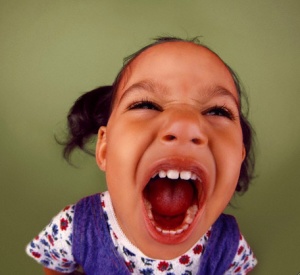The question of what comes first, co-regulation or interaction was inspired by a conversation that I had with music therapy colleague regarding helping a child, who has difficulty modulating his emotions, maintain reciprocal interactions for a sustain period of time. Here’s the short of it:
This particular child, Peter, displays difficulty sustaining reciprocal interactions due to his challenges dealing with emotional modulation. Thus, his ability to co-regulate for extended periods is constricted by challenges related to modulating his emotions while interacting. Simply put, his emotional range 1-dimensional, meaning that it expresses ONLY in the extremes, i.e., 0-100. Following 10-15 circles or 4-5 measures of back and forth musical-play interaction, Peter becomes “overloaded” emotionally as well as sensorily and withdraws from the interaction in a hypo responsive manner by becoming agitated while attempting to leave the room in a very aggressive manner.
So…what to do when the child becomes emotionally “overloaded,” dysregulated and wants to leave the room? There are two sides or opinions as to possibly work with this particular child during these challenging moments. One side of the discussion suggests, “first, YOU need to regulate the child. YOU can not do anything with him until he is completely regulated and attentive. Thus, stop the play and begin to calm him down. Once he is regulated, then return musical engagement. In addition, musical-play, be very sensitive and careful not to dysregulate him. If the child does become dysregulated, the play must stop again and techniques should be focused on regulated him. This may involve placing him in his seat, or provide some type of sensory input e.g., weighted vest, brushing, etc. Again, once he is regulated then the interaction begins.”
The other side of the coin, however, and this would be my suggestion, is first to realize that Peter is his own agent and we are not doing anything to him in order to get him to do something. My task, as the therapist, would be to provide him with experiences that will help foster relatedness and co-regulation. We are working together as a team. That being said, self-regulation as well as co-regulation should be fostered co-activly with the child. This should be done within the context of related musical-play. Thus, it is within the context of related musical-play in which Peter may or may not regulate. In addition, it is recommended that the therapist process and attempting to understand the child’s behavior developmentally and within the context of relationship occurring in-the-moment. Here are just a few questions that come to mind that you may think about when working with Peter:
- Why is the child dysregulating?
- When within the interaction does the child dysregulate?
- Is it sensory overload?
- Is it something emotional that is connected to the musical interaction?
- What types of musical contexts have I been providing for the child?
- too loud? too soft? too fast?
- too slow?
- Are the musical experiences demanding too much or too little?
- where does the music need to “go” in terms of composition and form
- Is it anxiety or challenges with regulation?
- How can I develop or create a musical-play intervention that captures his attention and the essence of his emotionality while fostering interaction?
- Is my affect congruent to his?
- Who’s needs am I meeting?
- Am I trying to lead him or am I really listening to what is happening?
- Are my clinical interventions based on him or catering to my tendencies, comfort and/or discomfort?
After attempting to understand what may be occurring for Peter, the therapist’s task and clinical objective isn’t so much about self-regulation as it is about providing musical experiences to help foster the child’s ability to sustain long robust chains of interaction. The self and co-regulation are natural products that occur in robust back-and-forth interaction in which the child and therapist are in tuned with each other, affectively. This means working through and “in” self-regulation and emotional modulation challenges within the interactions. Helping the child maintain relatedness during challenging moments is where the therapy lives and breathes, hence, working together within the context of relationship is extremely important. Self-regulation and co-regulation can not be experienced or learned in isolation. One needs to be co-regulated to someone or something.
Best,
John

